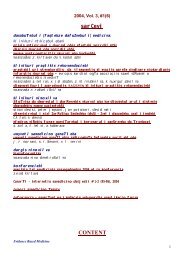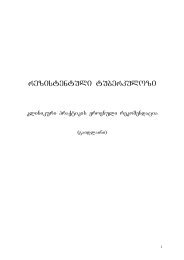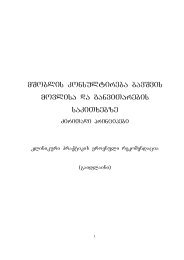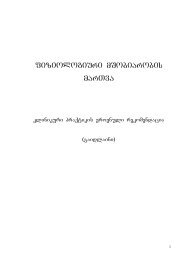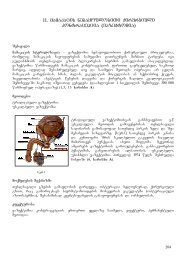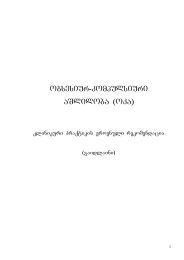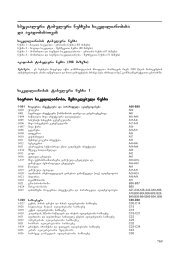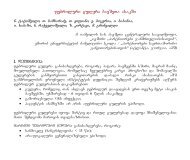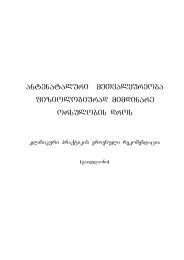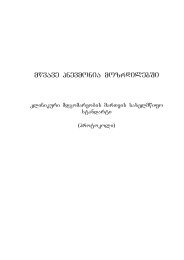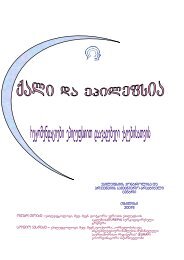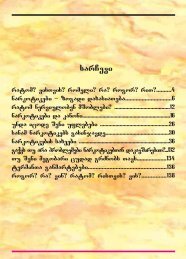aiv infeqcia/SidsiT avadmyofTa mkurnaloba da movla (klinikuri ...
aiv infeqcia/SidsiT avadmyofTa mkurnaloba da movla (klinikuri ...
aiv infeqcia/SidsiT avadmyofTa mkurnaloba da movla (klinikuri ...
Create successful ePaper yourself
Turn your PDF publications into a flip-book with our unique Google optimized e-Paper software.
Suppl 2:S171–176.<br />
73. Altice FL, Mostashari F, Friedland GH. Trust and the acceptance of and adherence to antiretroviral<br />
therapy. Journal of Acquired Immune Deficiency Syndromes, 2001, 28(1):47–58.<br />
74. Claxton AJ, Cramer J, Pierce C. A systematic review of the associations between dose regimens and<br />
medication compliance. Clinical Therapeutics, 2001, 23(8):1296–1310.<br />
75. Bartlett JA et al. Overview of the effectiveness of triple combination therapy in antiretroviral-n<strong>aiv</strong>e<br />
HIV-1-infected adults. AIDS, 2001, 15(11):1369–1377.<br />
76. Paterson DL et al. Adherence to protease inhibitor therapy and outcomes in patients with HIV infection.<br />
Annals of Internal Medicine, 2000, 133(1):21–30.<br />
77. Fumaz CR et al. Quality of life, emotional status, and adherence of HIV-1-infected patients treated<br />
with efavirenz versus protease inhibitor-containing regimens. Journal of Acquired Immune Deficiency<br />
Syndromes, 2002, 29(3):244–253.<br />
78. Bartlett JA. Addressing the challenges of adherence [review]. Journal of Acquired Immune Deficiency<br />
Syndromes, 2002, 29 Suppl. 1:S2–S10.<br />
79. Moore AL et al. Raised viral load in patients with viral suppression on highly active antiretroviral<br />
therapy: transient increase or treatment failure AIDS, 2002, 16(4):615–618.<br />
80. Nettles RE et al. Intermittent HIV-1 viremia (Blips) and drug resistance in patients receiving HAART.<br />
JAMA, 2005, 293(7):817–829.<br />
81. Le Moing V et al. Predictors of long-term increase in CD4(+) cell counts in human immunodeficiency<br />
virus-infected patients receiving a protease inhibitor-containing antiretroviral regimen. Journal of Infectious<br />
Diseases, 2002, 185(4):471–480.<br />
82. Smith CJ et al. Factors influencing increases in CD4 cell counts of HIV-positive persons receiving<br />
longterm highly active antiretroviral therapy. Journal of Infectious Diseases, 2004, 190(10):1860–1868.<br />
83. Barrios A et al. Paradoxical CD4+ T-cell decline in HIV-infected patients with complete virus suppression<br />
taking tenofovir and di<strong>da</strong>nosine. AIDS, 2005, 19(6):569–575.<br />
84. Gallant JE et al. Efficacy and safety of tenofovir DF vs stavudine in combination therapy in antiretroviraln<strong>aiv</strong>e<br />
patients: a 3-year randomized trial. JAMA, 2004, 292(2):191–201.<br />
85. Miller MD et al. Decreased replication capacity of HIV-1 clinical isolates containing K65R or M184V<br />
RT mutations. 10th Conference on Retroviruses and Opportunistic Infections (CROI), Boston, 10–14<br />
February 2003 (Abstract 616).<br />
86. Parikh U et al. K65R: a multinucleoside resistance mutation of increasing prevalence exhibits bidirectional<br />
phenotypic antagonism with TAM. 11th Conference on Retroviruses and Opportunistic Infections<br />
(CROI), San Francisco, 8–11 February 2004 (Abstract 54).<br />
87. Condra JH et al. Drug resistance and predicted virologic responses to human immunodeficiency virus<br />
type 1 protease inhibitor therapy. Journal of Infectious Diseases, 2000, 182(3):758–765.<br />
88. Kempf DJ et al. Analysis of the virological response with respect to baseline viral phenotype and genotype<br />
in protease inhibitor-experienced HIV-1-infected patients receiving lopinavir/ritonavir therapy.<br />
Antiviral Therapy, 2002, 7(3):165–174.<br />
89. Martinez-Picado J et al. Replicative fitness of protease inhibitor-resistant mutants of human<br />
immunodeficiency<br />
virus type 1. Journal of Virology, 1999, 73(5):3744–3752.<br />
90. Albrecht MA et al. Nelfinavir, efavirenz, or both after the failure of nucleoside treatment of HIV infection.<br />
The New England Journal of Medicine, 2001, 345(6):398–407.<br />
91. Kessler H et al. CD4 cell increases through more than 4 years in antiretroviral-naïve HIV+ patients<br />
treated with lopinavir/ritonavir-based therapy. The 2nd IAS Conference on HIV Pathogenesis and Treatment,<br />
International AIDS Society and ANRS, Paris, 13 July 2003 (Abstract 568). 1-38 HIV/AIDS TREATMENT AND CARE<br />
CLINICAL PROTOCOLS FOR THE WHO EUROPEAN REGION<br />
92. Abbott’s new Kaletra tablet gets EMEA CHMP’s OK. Therapeutics Daily, 8 May 2006 (http://www.<br />
therapeutics<strong>da</strong>ily.com/News/article.cfmcontenttype=sentryarticle&contentvalue=884529&channelID<br />
=31, accessed May 9, 2006).<br />
93. Johnson M et al. 96-week comparison of once-<strong>da</strong>ily atazanavir/ritonavir and twice-<strong>da</strong>ily lopinavir/ritonavir<br />
in patients with multiple virologic failures. AIDS, 2006, 20(5):711–718.<br />
94. Youle M et al. The final week 48 analysis of a phase IV randomised open label multicetre trial to evaluate<br />
safety and efficacy of lopinavir/ritonavir vs saquinavir/ritonavir in adult HIV-1 infection: the MaxCMin2<br />
study. The 2nd IAS Conference on HIV Pathogenesis and Treatment, International AIDS Society<br />
and ANRS, Paris, 13 July 2003 (Abstract LB23).<br />
95. Rottmann C et al: Atazanavir ritonavir saquinavir without any other antiretroviral drugs in protease<br />
inhibitor experienced patients with no reverse transcriptase options: a 24 week cohort analysis. 7th<br />
International Congress on Drug Therapy in HIV Infection, Glasgow, 14–18 November 2004 (Abstract P21).<br />
96. Lazzarin A et al. Efficacy of enfuvirtide in patients infected with drug-resistant HIV-1 in Europe and<br />
70



